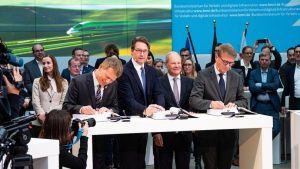 Germany’s Minister of Transport, Andreas Scheuer, Deutsche Bahn CEO, Richard Lutz, and DB Board Member for Infrastructure, Ronald Pofalla, signed the EUR 86 billion LuFV III service and financing agreement.
Germany’s Minister of Transport, Andreas Scheuer, Deutsche Bahn CEO, Richard Lutz, and DB Board Member for Infrastructure, Ronald Pofalla, signed the EUR 86 billion LuFV III service and financing agreement.
The rail infrastructure programme for 2022-2029 is 54% higher than the previous planning period. The federal government will provide EUR 62 billion, while DB is contributing with EUR 24 billion, representing a 44% increase for company’s spending. In addition, the dividend payments from DB infrastructure companies will be fully reinvested.
“The wow era effect is coming. The 2020s will be a brilliant era for rail. We sign the largest modernisation programme ever in Germany. Our goal is to have a strong, powerful and high-quality network as the basis for active climate protection in transport. We are replacing obsolete systems, creating accessibility, improving construction site management with a maximum benefit for the passengers,” Andreas Scheuer said at the ceremony held on 14 January.
Under the LuFV III, 2000 km of track and 2000 switches will be annually renewed. The 10-year programme also includes the renovation of 2000 bridges and EUR 7 billion will be invested for the renewal of interlockings.
“We are well prepared for the next decade of our railways. The infrastructure is the basis not only for growth and modal shift, but also for operational quality and high punctuality. With the new service and financing agreement, we can tackle the investment backlog and fundamentally modernise the infrastructure. This will make the rail network more robust and reliable, and stations will become more attractive,” Lutz said.
The programme creates more planning security for DB and the economy and allows long-term agreements with construction and planning suppliers. The ministry says that this is an incentive for more capacity and innovation in the railway construction industry.
“The new service and financing agreement is the foundation for more quality and stability of the rail transport. It is the start of a modernisation offensive on the German rail network that has never existed on this scale. We will work closely with the construction industry. Together we can now plan a much longer period and thus secure capacities,” Profalla explained.
The service and financing agreement is based on comprehensive transparency and control. The Federal Railway Authority monitors how the agreement is implemented. 17 criteria were agreed to measure the success of the agreement. If DB fails to meet the contractual requirements, fines will be due. Quality indicators document the status of the network, how many bridges have been renewed, how much funds go into maintenance and much more.
LuFV regulates the replacement of the assets on the existing railway network, determines quality indicators and applies sanctions for non-compliance.
The agreement is based on comprehensive transparency and control. The Federal Railway Authority monitors LuFV implementation for which 17 criteria were agreed to measure the success of LuFV III. If DB fails to meet the contractual requirements, fines will be applied. The quality indicators document the status of the network, such as the number of bridges which have been renewed as well as how much funding will be allotted for the maintenance.
Share on:



